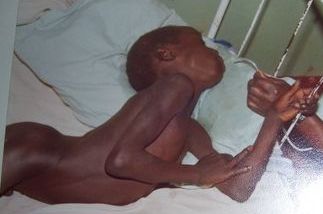Tetanus
- font size decrease font size increase font size
 Tetanus is a condition of toxaemia due to absorption of soluble toxin from the wound contaminated with clostridium tetani. The word tetanus comes from the Greek, tetanos, which is derived from the word teinein meaning stretch.
Tetanus is a condition of toxaemia due to absorption of soluble toxin from the wound contaminated with clostridium tetani. The word tetanus comes from the Greek, tetanos, which is derived from the word teinein meaning stretch.
Due to the extensive worldwide vaccination campaign, cases of tetanus are in persons who have either never been vaccinated (esp. neonates) or who completed a primary series but have not had a booster in the preceding 10 years.
Causative agent
 Nicolaier discovered the anaerobic bacillus clostridium tetani in1885. It is a none capsulated, gram positive, spore forming rod with terminal round spore (giving it a drum stick appearance). It is mainly found in soil and manure. It is also a normal inhabitant of the intestines (10-25% of human GI tract).
Nicolaier discovered the anaerobic bacillus clostridium tetani in1885. It is a none capsulated, gram positive, spore forming rod with terminal round spore (giving it a drum stick appearance). It is mainly found in soil and manure. It is also a normal inhabitant of the intestines (10-25% of human GI tract).
Modes of Entry
- Penetrating wound and dirty abrasions
- Chronic ulcers, boils, paronchyia and dental extractions
- Contamination of cut surface of umbilical cord (tetanus neonatorum)
- Urban tetanus- complication of narcotic addiction
- Subcutaneous injection of an irritant like emetine.
- Medical manipulations- Post –operative tetanus, post –abortal and puerperal tetanus
Pathophysiology
The spores need tissue with the proper anaerobic conditions to germinate, i.e. necrotizing wounds. Under anaerobic conditions the spores of clostridium tetani germinate and produce exotoxin. The exotoxin consists of two components:
- Tetanospasmin – a neurotoxin that acts on the motor end plates (highly potent- causes clinical manifestations)
- Tetanolysin – an oxygen labile haemolytic toxin (is not believed to be of any significance in the clinical course of tetanus.)
The manifestations of the disease are due to absorption of soluble exotoxin from the site of infection. Tetanospasmin that is released by the maturing bacilli is distributed via the lymphatic and vascular circulations to the end plates of all nerves. Tetanospasmin then enters the nervous system peripherally at the myoneural junction and is transported centripetally into neurons of the central nervous system. These neurons become incapable of neurotransmitter release. Due to failure of inhibition of motor reflex responses to sensory stimulation, there is generalized contractions of the agonist and antagonist musculature characteristic of a tetanic spasm. Once the toxin becomes fixed to neurons, it cannot be neutralized with antitoxin.
Incubation
In general, the further the injury site is from the central nervous system, the longer the incubation period. It varies from 3 days to 3 weeks but on average it is 7 days.
Classification
On the basis of clinical findings, four different forms of tetanus have been described.
- Generalized – most common type
- Localized- generally milder. Patients have persistent contraction of muscles in the same anatomic area as the injury.
- Neonatal - a generalized tetanus that occurs in newborns
- Cephalic - rare form usually occur after ear infections(otitis media)
Tetanus may also be classified as
- Acute
- Chronic
- Latent
- Bulbar
- Recurrent
Clinical Signs
The signs and symptoms depend largely on the incubation period. The shorter the incubation period, the more severe the symptoms.
- Trismus also known as lockjaw is the most common early symptom (occurs in 75% of cases)
- Other presenting complaints include stiffness, neck rigidity, dysphagia, restlessness, and reflex spasms.
- Subsequently, muscle rigidity becomes the major manifestation. The rigidity spreads in a descending pattern from the jaw and facial muscles over the next 24-48 hours to the extensor muscles of the limbs and back is slightly arched (opisthotonus). Sustained contraction of facial musculature produces a sneering grin expression known as risus sardonicus.
- Occasionally dysphagia may appear first. It occurs in moderately severe tetanus due to pharyngeal muscle spasms, and onset is usually insidious over
 several days.
several days. - Reflex spasms develop in most patients and can be triggered by minimal external stimuli such as noise, light, or touch. The spasms last seconds to minutes; become more intense; increase in frequency with disease progression; and can cause apnea, fractures, dislocations, and rhabdomyolysis.
- Laryngeal spasms can occur at any time and can result in asphyxia.
- Other symptoms include elevated temperature, sweating, elevated blood pressure, and episodic rapid heart rate.
- Neonatal tetanus presents with an inability to suck 3-10 days after birth. Presenting symptoms include irritability, excessive crying, grimaces, intense rigidity, and opisthotonus.
Treatment
Treatment of tetanus is directed toward the neutralization of circulating toxin to prevent the continued spread, elimination of the source, treatment of muscle spasm, prevention of respiratory and metabolic complications.
- Passive immunization –either, humotet (ATG) administered alongside with tetanus toxoid injection; or ATS given half i/v and half i/m.
- Antibiotics- high doses of penicillin or its supplements
- Wound care- debridement of wounds to remove organisms and to create an aerobic environment.
- Maintain a dark and quiet environment for the patient and avoid unnecessary procedures and manipulations (because of the risk of reflex spasms).
- Further treatment depends on severity of the disease.
Prophylaxis
Tetanus can be prevented by vaccination with tetanus toxoid.
Active immunization
Done by formol toxoid or alum precipitated toxoid. For children the toxoid is given alongside toxoid of diphtheria and pertussis (DPT). The tetanus dose is given thrice. Only after the third dose, is the series considered complete. The vaccine should last years with requirement for booster injections every 10yrs (depending on your country’s health policy)
Passive immunization
Equine ATS- short term effect(2weeks) usually given to previously not immunized patient at time of injury.
Humotet ( human antitetanus globulin – better than ATS as no skin test is required and its protective value is a hundred times more.
Tetanus –a lethal condition and cause of mortality- remains a threat despite widespread immunization.
